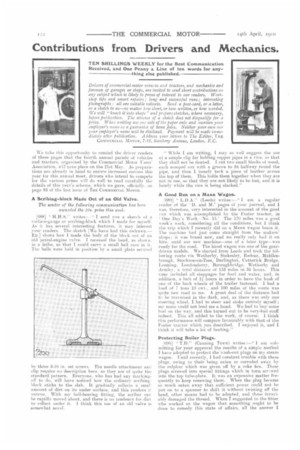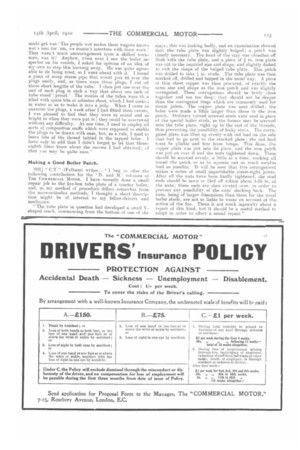Contributions from Drivers and Mechanics.
Page 20

Page 21

If you've noticed an error in this article please click here to report it so we can fix it.
TEN SHILLINGS WEEKLY for the Best Communication Received, and One Penny a Line of ten words for any thing else published.
Drivers of commercial-motor vehicles and tractors, and mechanics and foremen of garages or shops, are invited to send short contributions on any subject which is likely to Prove of interest to our readers. Workshop tips and smart repairs ; long and successful runs ; interesting photographs : nfl are suitable subjects. Send a post-card, or a letter, or a sketch to us—no matter how short, or how written, or how worded. We will " knock it into shape" and prepare sketches, where necessary, before publication. The absence of a sketch does not disqualify for a prize. When writing use one side of the paper only and mention your employer's name as a guarantee of bona fides. Neither your own nor your employer's name will be disclosed. Payment will be made immediately after publication. Address your letters to The Editor, THE COMMERCIAL MOTOR, 7-15, kosebery Avenue, London, E.C.
We take this opportunity to remind the driver readers of these pages that the fourth annual parade of vehicles and tractors, organized by the Commercial Motor Users' Association, will take place On the 21st May. As preparations are already in hand to ensure increased success this year for this annual meet, drivers who intend to compete for the various prizes will do well to read direfully the details of this year's scheme, which we gave, officially, on page 83 of the last issue of THE COMMERCIAL Moron.
A Scribing-block Made Out of an Old Valve.
The sender of the following communication boo been awarded the Ths. prize this week.
[688] " 1-1,1-1.S," writes: " I send you is sketch oi a surface-gauge or scribing-block which I made for myself. As it has several interesting features, it may interest your readers. The sketch [We have had this redrawn.— En.] shows how I made the body of the block out of an old petrol-engine valve. T recessed the head, as shown. in a lathe, so that I could carr:v a small ball race in it. The balls were held in position by a small plate secured by three 3-16 in. set screws. The needle attachment and clip require no description here, as they are of quite the standard pattern. Everyone, who has had any markingoff to do, will have noticed how the ordinary scribing block sticks to the slab. It gradually collects a small amount of dirt. on its tinder surface, and this renders it untrue. With my ball-bearing fitting, the scriber ear be rapidly moved about, and there is no tendency for dirt to collect under it. 1 think this use of an old valve is somewhat novel. " While I am writing, 1 may as well suggest the use of a simple clip for holding copper pipes in a vice, so that they shall not he dented. I cut two small blocks of wood, each scooped out with a groove to fit halfway round the pipe, and then 1 loosely tack a. piece of leather across the top of them. This holds them together when they are not in use, so that they are not likely to be lost, and it is handy while the vice is being slacked."
A Good Run on a Mann Wagon.
r6891 " L.D.A." (Leeds) writes:—" I ant a regular reader of the ' D. and M.' pages of your journal, and 1 was, therefore, very interested in the account of the good run which was accomplished by the Foster tractor, in One Day's Work. -No. 15.' The. 170 miles was a good week's work, considering all the conditions, but 1 think the trip which I recently did on a Mann wagon beats it. The machine had just come straight front the makers' shops; it was hi-and new, and we really only had it on hire, until our new machine—one of a later type—was ready for the road. The hired wagon was one of the geardriven models. We, started from Leeds and took the following route via Wetherhy, Stokesley, Redear, Middlesbrough, Stockton-on-Tees, Darlington, Catteriek Bridge, Leeming. Londonderry, Boroughbridge, Wetherby and Armley, is total distance of 153 miles in 34 hours. This time included all stoppages for food and water, and, in addition, a halt of 1* hours in order to have the bush of one of the back wheels of the trailer fastened. I had a load of 7 tons 10 cwt., and 100 miles of the route was quite new road to me. A great deal of the distance had to be traversed in the dark, and, as there was only one steering wheel, I had to steer and stoke entirely myself ; my mate could not lend me a hand. We had to buy some fuel on the way, and this turned out to be very-bad stuff indeed. This all added to the work, of course. I think this performance will compare favourably with that of the Foster tractor which you described. I enjoyed it and I think it will take a lot of beating."
Protecting Boiler Plugs.
[690] " TI)." (Canning Town) writes;—" 1 am submitting for your approval the results of a simple method I have adopted to protect the'wash-out plugs on my steam wagon. Until recently, I had constant trouble with these plugs, owing to their being eaten or corroded away by the sulphur which was given off by a coke fire. These plugs screwed into special fittings which in turn scrnved into the top tube-plate. It was an expensive matter frequently to -keep renewing them. When the plug became so much eaten away that sufficient power could not be put on to a spanner to shift it without twisting off the head, other means had to be adopted, and these invariably damaged the thread. When I suggested to the fitter who worked on the wagon that something ought to be done to remedy this state of affairs, all the answer I could get was ' The people wot makes them wagons knows wets hest fur 'em, we mustn't interfere with their work.' That wasn't much encouragement irom a skilled workman, was it? Anyhow, when next I saw the boiler inspector on his rounds, I asked his opinion of an idea of my own to stop this burning away. He was quite agreeable to its being tried, so I went ahead with it. I found a piece of scrap steam pipe that would just lit over the plugs easily, and, as there were three plugs, I cut off three short lengths of the tube. I then put one over the end of each plug in such a way that about one inch of tube stood proud.' The insides of the tubes were thin filled with spare bits of asbestos sheet, which I had soakea in water so as to make it into a pulp. When I came to examine the plugs, a week after I had fitted these covers, I was pleased to find that they were as sound and as bright as when they were put in; they could he unscrewed without any difficulty. At one time, I used to employ ail sorts of composition stuffs which were supposed to enable the plugs to be drawn with ease, but, as a rule, I used to leave bits of the thread behind in the tapped holes. I have only to add that I didn't forget to let that threeeighth fitter know about the sueeess I had obtained; of that you may be quite sure."
Making a Good Boiler Patch.
16911 " C.T." (Fulham) writes:—" I beg to offer the following contribution for the D. and M.' columns of THE COMMERCIAL MOTOR. I have recently done a small repair job to the fire-box tube plate of a tractor boiler, and, as my method of procedure differs somewhat from the more-orthodox methods, I thought a short description might be of interest to my fellow-drivers and mechanics.
"The tube plate in question had developed a small Vshaped crack, commencing from the bottom of one of the
stays; this was leaking badly, and an examination showed that the tube plate was slightly bulged; a patch was clearly necessary. The head of the stay was chiselled off flush with the tube plate, and a piece of in. iron plate was cut to the required size and shape, and slightly dished to suit the shape of the bulged tube plate. This patch was drilled to take in. studs. The tube plate was then marked off, drilled and tapped in the usual way. A piece of thin sheet copper was then procured, of exactly the same size and shape as the iron patch and was slightly corrugated. These oorrugation6 should be fairly close together and not too deep; they should not be deeper than the corrugated rings which are commonly used for steam joints. The copper plate was next drilled; the holes were made a little larger than those in the. iron patch. Ordinary turned screwed studs were used in place of the special boiler studs, as the former may be screwed into the tube plate, right up to the end of the threads, thus preventing the possibility of leaky stuos. The corrugated plate was filled up evenly with red lead on the side that had to go next to the cracked plate; the red lead must he pliable and free from lumps. This done, the (ripper plate was put into its place, and the iron patch was put on over it and the nuts tightened down. These sheuld be screwed evenly, a, little at a time, working all round the patch so as to squeeze out as much surplus lead as possible. It will be seen that this arrangement makes a. series of small imperishable steam-tight joints. After all the nuts have been finally tightened, the stud ends should be sawn or filed off within about 1-16 in. of the nuts; these ends are then riveted over, in order to prevent any possibility of the nuts' slacking back. The nuts, being of larger dimensions than those for the usual boiler studs, are not so liable to waste on account of the action of the fire. There is not much ingenuity about a repair of this kind, but it should be a useful method to adopt in order to effect a sound repair."






















